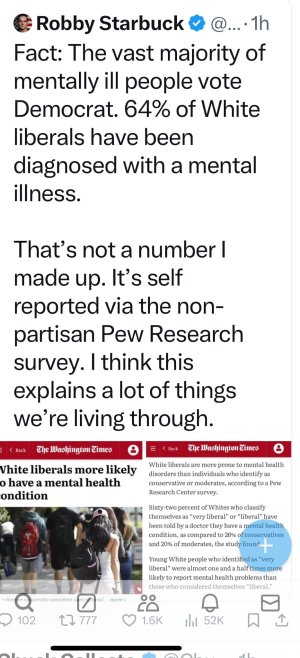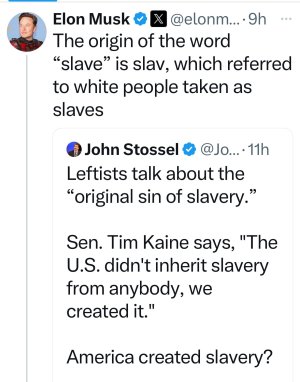Never stick your finger in a 220 outlet.Drill Baby Drill
Farm Baby Farm
Deport Baby Deport
^^anyone want to bet he's never done any police work in his life, just a PR lackeySHARIA: UK Police Commissioner Threatens to Extradite, JAIL American Citizens Over Online Posts: ‘We’ll Come After You’ - Geller Report
This is sharia law. Under Islamic law, any criticism of Islam is criminal.We have a First Amendment despite the left's war on free speech. Despite that, The Biden/Harris regime would most likely allow it. When I was banned from the UK (along with my colleague Robert Spencer) for my pro-Israel...gellerreport.com

🐸 Trust the plan on GETTR: YOU THINK EVERYTHING IS A JOKE ❗️ WATCH THIS ❗️ 🤬...
YOU THINK EVERYTHING IS A JOKE ❗️ WATCH THIS ❗️ 🤬🤬🤬🤬gettr.com
View attachment 220751
^^this twat determines online hate speech and what's appropriate
-
Pat Flood (@rebarcock) passed away 9/21/25. Pat played a huge role in encouraging the devolopmemt of this site and donated the very first dollar to get it started. Check the thread at the top of the board for the obituary and please feel free to pay your respects there. I am going to get all the content from that thread over to his family so they can see how many people really cared for Pat outside of what they ever knew. Pat loved to tell stories and always wanted everyone else to tell stories. I think a great way we can honor Pat is to tell a story in his thread (also pinned at the top of the board).
You are using an out of date browser. It may not display this or other websites correctly.
You should upgrade or use an alternative browser.
You should upgrade or use an alternative browser.
Master Thread Dance Your Cares Away/Fraggle/Law Abiding Citizens
- Thread starter Bryan74b
- Start date
Master Threads
My first house was $47k at 16%Have you looked at the interest rates in the 70's? I believe my parents first mortgage rate was 18%. I will give you that the house cost about 90k, but they probably made about 35k combined. Not good news either way though.
Ok I Know Long Post
But Worth Reading Every Word
I've Posted a Treat at the End for Those That Read All The Way to the End
Part 1
The global economy is on the verge of an unprecedented collapse, and the warning signs are already emerging in 2024. Over the next two years, the world will experience a series of economic shocks that will culminate in 2026, when everything unravels.
Despite the Federal Reserve’s recent efforts to control inflation through interest rate hikes and monetary tightening, deeper structural issues remain unresolved. Rising unemployment, an overvalued stock market, a housing bubble poised to burst, and the rapid advancement of artificial intelligence—threatening to displace millions of jobs—are all converging to create an economic storm.
Adding to this volatile mix is the U.S. government’s ballooning fiscal deficit, the worrying Nasdaq 100 to Russell 2000 ratio, which exceeds levels seen during the dot-com bubble, and the potential for Western governments to introduce universal basic income (UBI) to stave off social unrest.
This move will inevitably lead to more money printing, reigniting the inflation cycle after the crash. By 2026, the S&P 500 could plummet to 2100, the Nasdaq 100 may fall to between 6000 and 7000, and the global economy could enter a deep and prolonged recession.
The Crisis Unfolds:
2024 to 2026The economic crisis set to explode in 2026 is already beginning to take shape in 2024. The warning signs are clear: rising interest rates are squeezing businesses, consumer spending is slowing, and layoffs are spreading across key industries. Over the next two years, these conditions will worsen, setting the stage for a broader economic collapse.
By 2025, unemployment will have surged, straining entire sectors of the economy. The housing market, propped up by speculative investment and low interest rates, will start to crack as higher borrowing costs drive down demand. Meanwhile, the stock market—particularly the tech-heavy Nasdaq—will begin to show signs of instability as overvalued tech stocks become increasingly vulnerable to a sharp correction. By 2026, the economic landscape will be in shambles, with the worst yet to come.
Part 2 to Follow
But Worth Reading Every Word
I've Posted a Treat at the End for Those That Read All The Way to the End
Part 1
The global economy is on the verge of an unprecedented collapse, and the warning signs are already emerging in 2024. Over the next two years, the world will experience a series of economic shocks that will culminate in 2026, when everything unravels.
Despite the Federal Reserve’s recent efforts to control inflation through interest rate hikes and monetary tightening, deeper structural issues remain unresolved. Rising unemployment, an overvalued stock market, a housing bubble poised to burst, and the rapid advancement of artificial intelligence—threatening to displace millions of jobs—are all converging to create an economic storm.
Adding to this volatile mix is the U.S. government’s ballooning fiscal deficit, the worrying Nasdaq 100 to Russell 2000 ratio, which exceeds levels seen during the dot-com bubble, and the potential for Western governments to introduce universal basic income (UBI) to stave off social unrest.
This move will inevitably lead to more money printing, reigniting the inflation cycle after the crash. By 2026, the S&P 500 could plummet to 2100, the Nasdaq 100 may fall to between 6000 and 7000, and the global economy could enter a deep and prolonged recession.
The Crisis Unfolds:
2024 to 2026The economic crisis set to explode in 2026 is already beginning to take shape in 2024. The warning signs are clear: rising interest rates are squeezing businesses, consumer spending is slowing, and layoffs are spreading across key industries. Over the next two years, these conditions will worsen, setting the stage for a broader economic collapse.
By 2025, unemployment will have surged, straining entire sectors of the economy. The housing market, propped up by speculative investment and low interest rates, will start to crack as higher borrowing costs drive down demand. Meanwhile, the stock market—particularly the tech-heavy Nasdaq—will begin to show signs of instability as overvalued tech stocks become increasingly vulnerable to a sharp correction. By 2026, the economic landscape will be in shambles, with the worst yet to come.
Part 2 to Follow
Part 2
The Stock Market:
A Bubble on the Verge of Bursting The stock market, particularly the technology sector, is a bubble waiting to burst. The Nasdaq 100 to Russell 2000 ratio, a key indicator of tech stock valuations relative to smaller companies, has reached levels even higher than those seen during the dot-com bubble. This shows that tech stocks are not just overvalued—they are in a massive bubble that is primed to burst.
As interest rates rise and the economic environment becomes more challenging, the profitability of tech companies will be squeezed, leading to a sharp decline in their stock prices. When this bubble bursts, the consequences will be severe. The Nasdaq 100 could drop to between 6000 and 7000, erasing trillions of dollars in wealth. The S&P 500, heavily influenced by the tech sector, will also crash, likely falling to 2100. This correction will not just be a market adjustment; it will trigger a broader economic crisis with far-reaching consequences.
The housing market, much like the stock market, is another disaster waiting to happen. Years of low interest rates and speculative buying have driven home prices to unsustainable levels. With rising interest rates, the demand for housing will inevitably slow, leading to a severe decline in home prices.
By 2026, the housing market could be in freefall. Millions of homeowners who bought at the peak of the market will find themselves underwater, owing more on their mortgages than their homes are worth. The resulting wave of foreclosures will flood the market with distressed properties, driving prices down even further. The housing crash will have devastating consequences for the broader economy, leading to massive job losses in the construction and real estate sectors and wiping out trillions of dollars in home equity. The financial system will be hit hard, as banks and other lenders face increased losses from bad loans, deepening the economic crisis.
Artificial intelligence is also advancing rapidly, and by 2030, it will have a profound impact on the job market. AI-driven automation is set to displace millions of jobs across various sectors, contributing to rising unemployment and economic dislocation.
While AI promises significant gains in efficiency and productivity, its impact on employment will be devastating. Workers displaced by automation will struggle to find new jobs in an economy that is shrinking and becoming increasingly automated. This will lead to greater social unrest and political instability, as the divide between those who can adapt to the new economy and those who cannot widens. The economic consequences of this disruption will be severe, with reduced consumer spending and further pressure on corporate profits.
The U.S. government’s ballooning fiscal deficit is another major concern. The federal government has been running large deficits for years, financed largely through the issuance of Treasury securities. However, as the deficit continues to grow, the demand for U.S. Treasuries may begin to wane, particularly in an environment of rising interest rates.
By 2026, the U.S. government could face significantly higher borrowing costs, which will limit its ability to respond to the economic crisis with fiscal stimulus. This will further compound the economic downturn, as the government’s ability to provide support to the economy will be severely constrained. The potential for a fiscal crisis, in which the government is unable to finance its debt obligations, could further undermine confidence in the U.S. economy and contribute to a broader global economic crisis.
As the economic downturn deepens and unemployment rises, there is likely to be a significant increase in nationalist sentiment, particularly in Europe. Economic hardship will exacerbate existing tensions around immigration, with a growing number of people blaming immigrants for taking jobs at a time when employment opportunities are scarce. This sentiment will fuel populist political movements that advocate for tighter borders and reduced immigration, leading to a resurgence of nationalist policies across the continent.
Deportations could become more common as governments respond to public pressure to prioritize jobs for native citizens. With the job market under strain, many countries may reduce the number of immigrants they admit, and those already present may face increased scrutiny and hostility. This shift towards nationalism and protectionism could lead to a more fragmented and divided Europe, with significant implications for social cohesion and international relations.
The rise of nationalism and anti-immigrant sentiment will also have broader implications for global stability. As countries turn inward and adopt protectionist measures, international cooperation will weaken, making it more difficult to address global challenges such as climate change, pandemics, and economic instability. The social fabric of many nations will be tested, with the potential for increased social unrest and conflict.
As the economic crisis deepens and unemployment skyrockets, Western governments are likely to consider implementing universal basic income (UBI) as a desperate measure to prevent social unrest. The idea of providing a guaranteed income to all citizens, regardless of employment status, will be seen as a necessary step to maintain social stability in a time of economic hardship.
However, the implementation of UBI will come with significant costs. To fund this program, governments will be forced to print more money, further expanding the money supply at a time when stagflation is already a significant concern. This could lead to a new cycle of inflation, undermining any temporary relief provided by the basic income and exacerbating the economic crisis.
The introduction of UBI could also have unintended consequences for the labor market. With a guaranteed income, some workers may opt to leave the workforce altogether, leading to a further decline in productivity and economic output. This could create a vicious cycle in which the government is forced to print more money to fund the program, leading to even higher inflation and a deeper economic crisis.
As the U.S. grapples with its domestic economic challenges, its influence on the global stage is likely to weaken significantly. Economic difficulties at home will limit the U.S.’s ability to project power abroad, creating a power vacuum that other nations will be eager to fill. This shift in the global balance of power could lead to increased competition among global and regional powers, raising the risk of conflicts in various parts of the world.
In regions like the South China Sea, Eastern Europe, and the Middle East, the absence of strong U.S. leadership could lead to instability as emerging powers assert their influence. This could strain international alliances and complicate efforts to address global challenges, from climate change to security concerns.
The weakening of U.S. influence on the global stage could also have broader implications for global stability. As the U.S. retreats from its role as the guarantor of global order, other nations will be more inclined to pursue aggressive policies, leading to a more fragmented and unstable world.
While the economic downturn expected by 2026 will be severe, it is not the end of the world. Humanity has faced and overcome greater challenges in the past, and there is potential for recovery and renewal. However, the path forward will involve difficult adjustments, with widespread economic and social impacts.
This period of economic stress could lead to a reevaluation of existing economic models. The process will be challenging, but it also presents opportunity.
August 9, 2024
MFHOZ
Here is the Author - Fucking LAC Pin-Up Girl 2024
WOOD and Would Give Up Singlehood for This Sexy Mind

The Stock Market:
A Bubble on the Verge of Bursting The stock market, particularly the technology sector, is a bubble waiting to burst. The Nasdaq 100 to Russell 2000 ratio, a key indicator of tech stock valuations relative to smaller companies, has reached levels even higher than those seen during the dot-com bubble. This shows that tech stocks are not just overvalued—they are in a massive bubble that is primed to burst.
As interest rates rise and the economic environment becomes more challenging, the profitability of tech companies will be squeezed, leading to a sharp decline in their stock prices. When this bubble bursts, the consequences will be severe. The Nasdaq 100 could drop to between 6000 and 7000, erasing trillions of dollars in wealth. The S&P 500, heavily influenced by the tech sector, will also crash, likely falling to 2100. This correction will not just be a market adjustment; it will trigger a broader economic crisis with far-reaching consequences.
The housing market, much like the stock market, is another disaster waiting to happen. Years of low interest rates and speculative buying have driven home prices to unsustainable levels. With rising interest rates, the demand for housing will inevitably slow, leading to a severe decline in home prices.
By 2026, the housing market could be in freefall. Millions of homeowners who bought at the peak of the market will find themselves underwater, owing more on their mortgages than their homes are worth. The resulting wave of foreclosures will flood the market with distressed properties, driving prices down even further. The housing crash will have devastating consequences for the broader economy, leading to massive job losses in the construction and real estate sectors and wiping out trillions of dollars in home equity. The financial system will be hit hard, as banks and other lenders face increased losses from bad loans, deepening the economic crisis.
Artificial intelligence is also advancing rapidly, and by 2030, it will have a profound impact on the job market. AI-driven automation is set to displace millions of jobs across various sectors, contributing to rising unemployment and economic dislocation.
While AI promises significant gains in efficiency and productivity, its impact on employment will be devastating. Workers displaced by automation will struggle to find new jobs in an economy that is shrinking and becoming increasingly automated. This will lead to greater social unrest and political instability, as the divide between those who can adapt to the new economy and those who cannot widens. The economic consequences of this disruption will be severe, with reduced consumer spending and further pressure on corporate profits.
The U.S. government’s ballooning fiscal deficit is another major concern. The federal government has been running large deficits for years, financed largely through the issuance of Treasury securities. However, as the deficit continues to grow, the demand for U.S. Treasuries may begin to wane, particularly in an environment of rising interest rates.
By 2026, the U.S. government could face significantly higher borrowing costs, which will limit its ability to respond to the economic crisis with fiscal stimulus. This will further compound the economic downturn, as the government’s ability to provide support to the economy will be severely constrained. The potential for a fiscal crisis, in which the government is unable to finance its debt obligations, could further undermine confidence in the U.S. economy and contribute to a broader global economic crisis.
As the economic downturn deepens and unemployment rises, there is likely to be a significant increase in nationalist sentiment, particularly in Europe. Economic hardship will exacerbate existing tensions around immigration, with a growing number of people blaming immigrants for taking jobs at a time when employment opportunities are scarce. This sentiment will fuel populist political movements that advocate for tighter borders and reduced immigration, leading to a resurgence of nationalist policies across the continent.
Deportations could become more common as governments respond to public pressure to prioritize jobs for native citizens. With the job market under strain, many countries may reduce the number of immigrants they admit, and those already present may face increased scrutiny and hostility. This shift towards nationalism and protectionism could lead to a more fragmented and divided Europe, with significant implications for social cohesion and international relations.
The rise of nationalism and anti-immigrant sentiment will also have broader implications for global stability. As countries turn inward and adopt protectionist measures, international cooperation will weaken, making it more difficult to address global challenges such as climate change, pandemics, and economic instability. The social fabric of many nations will be tested, with the potential for increased social unrest and conflict.
As the economic crisis deepens and unemployment skyrockets, Western governments are likely to consider implementing universal basic income (UBI) as a desperate measure to prevent social unrest. The idea of providing a guaranteed income to all citizens, regardless of employment status, will be seen as a necessary step to maintain social stability in a time of economic hardship.
However, the implementation of UBI will come with significant costs. To fund this program, governments will be forced to print more money, further expanding the money supply at a time when stagflation is already a significant concern. This could lead to a new cycle of inflation, undermining any temporary relief provided by the basic income and exacerbating the economic crisis.
The introduction of UBI could also have unintended consequences for the labor market. With a guaranteed income, some workers may opt to leave the workforce altogether, leading to a further decline in productivity and economic output. This could create a vicious cycle in which the government is forced to print more money to fund the program, leading to even higher inflation and a deeper economic crisis.
As the U.S. grapples with its domestic economic challenges, its influence on the global stage is likely to weaken significantly. Economic difficulties at home will limit the U.S.’s ability to project power abroad, creating a power vacuum that other nations will be eager to fill. This shift in the global balance of power could lead to increased competition among global and regional powers, raising the risk of conflicts in various parts of the world.
In regions like the South China Sea, Eastern Europe, and the Middle East, the absence of strong U.S. leadership could lead to instability as emerging powers assert their influence. This could strain international alliances and complicate efforts to address global challenges, from climate change to security concerns.
The weakening of U.S. influence on the global stage could also have broader implications for global stability. As the U.S. retreats from its role as the guarantor of global order, other nations will be more inclined to pursue aggressive policies, leading to a more fragmented and unstable world.
While the economic downturn expected by 2026 will be severe, it is not the end of the world. Humanity has faced and overcome greater challenges in the past, and there is potential for recovery and renewal. However, the path forward will involve difficult adjustments, with widespread economic and social impacts.
This period of economic stress could lead to a reevaluation of existing economic models. The process will be challenging, but it also presents opportunity.
August 9, 2024
MFHOZ
Here is the Author - Fucking LAC Pin-Up Girl 2024
WOOD and Would Give Up Singlehood for This Sexy Mind

My first house was $47k at 16%
Was that the "Natty Light" house before you upgraded to Coors?
Part 2
The Stock Market:
A Bubble on the Verge of Bursting The stock market, particularly the technology sector, is a bubble waiting to burst. The Nasdaq 100 to Russell 2000 ratio, a key indicator of tech stock valuations relative to smaller companies, has reached levels even higher than those seen during the dot-com bubble. This shows that tech stocks are not just overvalued—they are in a massive bubble that is primed to burst.
As interest rates rise and the economic environment becomes more challenging, the profitability of tech companies will be squeezed, leading to a sharp decline in their stock prices. When this bubble bursts, the consequences will be severe. The Nasdaq 100 could drop to between 6000 and 7000, erasing trillions of dollars in wealth. The S&P 500, heavily influenced by the tech sector, will also crash, likely falling to 2100. This correction will not just be a market adjustment; it will trigger a broader economic crisis with far-reaching consequences.
The housing market, much like the stock market, is another disaster waiting to happen. Years of low interest rates and speculative buying have driven home prices to unsustainable levels. With rising interest rates, the demand for housing will inevitably slow, leading to a severe decline in home prices.
By 2026, the housing market could be in freefall. Millions of homeowners who bought at the peak of the market will find themselves underwater, owing more on their mortgages than their homes are worth. The resulting wave of foreclosures will flood the market with distressed properties, driving prices down even further. The housing crash will have devastating consequences for the broader economy, leading to massive job losses in the construction and real estate sectors and wiping out trillions of dollars in home equity. The financial system will be hit hard, as banks and other lenders face increased losses from bad loans, deepening the economic crisis.
Artificial intelligence is also advancing rapidly, and by 2030, it will have a profound impact on the job market. AI-driven automation is set to displace millions of jobs across various sectors, contributing to rising unemployment and economic dislocation.
While AI promises significant gains in efficiency and productivity, its impact on employment will be devastating. Workers displaced by automation will struggle to find new jobs in an economy that is shrinking and becoming increasingly automated. This will lead to greater social unrest and political instability, as the divide between those who can adapt to the new economy and those who cannot widens. The economic consequences of this disruption will be severe, with reduced consumer spending and further pressure on corporate profits.
The U.S. government’s ballooning fiscal deficit is another major concern. The federal government has been running large deficits for years, financed largely through the issuance of Treasury securities. However, as the deficit continues to grow, the demand for U.S. Treasuries may begin to wane, particularly in an environment of rising interest rates.
By 2026, the U.S. government could face significantly higher borrowing costs, which will limit its ability to respond to the economic crisis with fiscal stimulus. This will further compound the economic downturn, as the government’s ability to provide support to the economy will be severely constrained. The potential for a fiscal crisis, in which the government is unable to finance its debt obligations, could further undermine confidence in the U.S. economy and contribute to a broader global economic crisis.
As the economic downturn deepens and unemployment rises, there is likely to be a significant increase in nationalist sentiment, particularly in Europe. Economic hardship will exacerbate existing tensions around immigration, with a growing number of people blaming immigrants for taking jobs at a time when employment opportunities are scarce. This sentiment will fuel populist political movements that advocate for tighter borders and reduced immigration, leading to a resurgence of nationalist policies across the continent.
Deportations could become more common as governments respond to public pressure to prioritize jobs for native citizens. With the job market under strain, many countries may reduce the number of immigrants they admit, and those already present may face increased scrutiny and hostility. This shift towards nationalism and protectionism could lead to a more fragmented and divided Europe, with significant implications for social cohesion and international relations.
The rise of nationalism and anti-immigrant sentiment will also have broader implications for global stability. As countries turn inward and adopt protectionist measures, international cooperation will weaken, making it more difficult to address global challenges such as climate change, pandemics, and economic instability. The social fabric of many nations will be tested, with the potential for increased social unrest and conflict.
As the economic crisis deepens and unemployment skyrockets, Western governments are likely to consider implementing universal basic income (UBI) as a desperate measure to prevent social unrest. The idea of providing a guaranteed income to all citizens, regardless of employment status, will be seen as a necessary step to maintain social stability in a time of economic hardship.
However, the implementation of UBI will come with significant costs. To fund this program, governments will be forced to print more money, further expanding the money supply at a time when stagflation is already a significant concern. This could lead to a new cycle of inflation, undermining any temporary relief provided by the basic income and exacerbating the economic crisis.
The introduction of UBI could also have unintended consequences for the labor market. With a guaranteed income, some workers may opt to leave the workforce altogether, leading to a further decline in productivity and economic output. This could create a vicious cycle in which the government is forced to print more money to fund the program, leading to even higher inflation and a deeper economic crisis.
As the U.S. grapples with its domestic economic challenges, its influence on the global stage is likely to weaken significantly. Economic difficulties at home will limit the U.S.’s ability to project power abroad, creating a power vacuum that other nations will be eager to fill. This shift in the global balance of power could lead to increased competition among global and regional powers, raising the risk of conflicts in various parts of the world.
In regions like the South China Sea, Eastern Europe, and the Middle East, the absence of strong U.S. leadership could lead to instability as emerging powers assert their influence. This could strain international alliances and complicate efforts to address global challenges, from climate change to security concerns.
The weakening of U.S. influence on the global stage could also have broader implications for global stability. As the U.S. retreats from its role as the guarantor of global order, other nations will be more inclined to pursue aggressive policies, leading to a more fragmented and unstable world.
While the economic downturn expected by 2026 will be severe, it is not the end of the world. Humanity has faced and overcome greater challenges in the past, and there is potential for recovery and renewal. However, the path forward will involve difficult adjustments, with widespread economic and social impacts.
This period of economic stress could lead to a reevaluation of existing economic models. The process will be challenging, but it also presents opportunity.
August 9, 2024
MFHOZ
Here is the Author - Fucking LAC Pin-Up Girl 2024
WOOD and Would Give Up Singlehood for This Sexy Mind

Lost me when she starting in about climate change.
Lost me when she starting in about climate change.
Yea her perfect set of ta-ta's caused me to overlook that flaw.
dirtytoeddawg
Legendary
Oppressed families seeking asylum from persecution, iyam...
First one was a van down by the river until the river dried up.Was that the "Natty Light" house before you upgraded to Coors?
Part 2
The Stock Market:
A Bubble on the Verge of Bursting The stock market, particularly the technology sector, is a bubble waiting to burst. The Nasdaq 100 to Russell 2000 ratio, a key indicator of tech stock valuations relative to smaller companies, has reached levels even higher than those seen during the dot-com bubble. This shows that tech stocks are not just overvalued—they are in a massive bubble that is primed to burst.
As interest rates rise and the economic environment becomes more challenging, the profitability of tech companies will be squeezed, leading to a sharp decline in their stock prices. When this bubble bursts, the consequences will be severe. The Nasdaq 100 could drop to between 6000 and 7000, erasing trillions of dollars in wealth. The S&P 500, heavily influenced by the tech sector, will also crash, likely falling to 2100. This correction will not just be a market adjustment; it will trigger a broader economic crisis with far-reaching consequences.
The housing market, much like the stock market, is another disaster waiting to happen. Years of low interest rates and speculative buying have driven home prices to unsustainable levels. With rising interest rates, the demand for housing will inevitably slow, leading to a severe decline in home prices.
By 2026, the housing market could be in freefall. Millions of homeowners who bought at the peak of the market will find themselves underwater, owing more on their mortgages than their homes are worth. The resulting wave of foreclosures will flood the market with distressed properties, driving prices down even further. The housing crash will have devastating consequences for the broader economy, leading to massive job losses in the construction and real estate sectors and wiping out trillions of dollars in home equity. The financial system will be hit hard, as banks and other lenders face increased losses from bad loans, deepening the economic crisis.
Artificial intelligence is also advancing rapidly, and by 2030, it will have a profound impact on the job market. AI-driven automation is set to displace millions of jobs across various sectors, contributing to rising unemployment and economic dislocation.
While AI promises significant gains in efficiency and productivity, its impact on employment will be devastating. Workers displaced by automation will struggle to find new jobs in an economy that is shrinking and becoming increasingly automated. This will lead to greater social unrest and political instability, as the divide between those who can adapt to the new economy and those who cannot widens. The economic consequences of this disruption will be severe, with reduced consumer spending and further pressure on corporate profits.
The U.S. government’s ballooning fiscal deficit is another major concern. The federal government has been running large deficits for years, financed largely through the issuance of Treasury securities. However, as the deficit continues to grow, the demand for U.S. Treasuries may begin to wane, particularly in an environment of rising interest rates.
By 2026, the U.S. government could face significantly higher borrowing costs, which will limit its ability to respond to the economic crisis with fiscal stimulus. This will further compound the economic downturn, as the government’s ability to provide support to the economy will be severely constrained. The potential for a fiscal crisis, in which the government is unable to finance its debt obligations, could further undermine confidence in the U.S. economy and contribute to a broader global economic crisis.
As the economic downturn deepens and unemployment rises, there is likely to be a significant increase in nationalist sentiment, particularly in Europe. Economic hardship will exacerbate existing tensions around immigration, with a growing number of people blaming immigrants for taking jobs at a time when employment opportunities are scarce. This sentiment will fuel populist political movements that advocate for tighter borders and reduced immigration, leading to a resurgence of nationalist policies across the continent.
Deportations could become more common as governments respond to public pressure to prioritize jobs for native citizens. With the job market under strain, many countries may reduce the number of immigrants they admit, and those already present may face increased scrutiny and hostility. This shift towards nationalism and protectionism could lead to a more fragmented and divided Europe, with significant implications for social cohesion and international relations.
The rise of nationalism and anti-immigrant sentiment will also have broader implications for global stability. As countries turn inward and adopt protectionist measures, international cooperation will weaken, making it more difficult to address global challenges such as climate change, pandemics, and economic instability. The social fabric of many nations will be tested, with the potential for increased social unrest and conflict.
As the economic crisis deepens and unemployment skyrockets, Western governments are likely to consider implementing universal basic income (UBI) as a desperate measure to prevent social unrest. The idea of providing a guaranteed income to all citizens, regardless of employment status, will be seen as a necessary step to maintain social stability in a time of economic hardship.
However, the implementation of UBI will come with significant costs. To fund this program, governments will be forced to print more money, further expanding the money supply at a time when stagflation is already a significant concern. This could lead to a new cycle of inflation, undermining any temporary relief provided by the basic income and exacerbating the economic crisis.
The introduction of UBI could also have unintended consequences for the labor market. With a guaranteed income, some workers may opt to leave the workforce altogether, leading to a further decline in productivity and economic output. This could create a vicious cycle in which the government is forced to print more money to fund the program, leading to even higher inflation and a deeper economic crisis.
As the U.S. grapples with its domestic economic challenges, its influence on the global stage is likely to weaken significantly. Economic difficulties at home will limit the U.S.’s ability to project power abroad, creating a power vacuum that other nations will be eager to fill. This shift in the global balance of power could lead to increased competition among global and regional powers, raising the risk of conflicts in various parts of the world.
In regions like the South China Sea, Eastern Europe, and the Middle East, the absence of strong U.S. leadership could lead to instability as emerging powers assert their influence. This could strain international alliances and complicate efforts to address global challenges, from climate change to security concerns.
The weakening of U.S. influence on the global stage could also have broader implications for global stability. As the U.S. retreats from its role as the guarantor of global order, other nations will be more inclined to pursue aggressive policies, leading to a more fragmented and unstable world.
While the economic downturn expected by 2026 will be severe, it is not the end of the world. Humanity has faced and overcome greater challenges in the past, and there is potential for recovery and renewal. However, the path forward will involve difficult adjustments, with widespread economic and social impacts.
This period of economic stress could lead to a reevaluation of existing economic models. The process will be challenging, but it also presents opportunity.
August 9, 2024
MFHOZ
Here is the Author - Fucking LAC Pin-Up Girl 2024
WOOD and Would Give Up Singlehood for This Sexy Mind

So for us non stock market experts n such, what do we do with our 401K balances so not to lose everything? Is there somewhere we can shift the balances to not take a huge hit when the crash does occur?
Welcome to the club Dawkins.
What a fucking moron....
Love Mr Bean
9Mounties07
Legendary
Who knew he could speak like thatLove Mr Bean
On returning to x. No. Unless they got the tracking thing controlled.
Last edited:
OPD77
Legendary
Fuck Darth Vader and Jabba The Cunt.OH LOOKThe guy who helped stage 9-11 then worked with the press to cover his tracks. Starting 20 years of war in Afghanistan, thousands lost their lives, but he and his globalist friends got rich. AND with him is his daughter, who helped plan J6 and then got on a committee that destroyed evidence that would have cleared all prisoners, but she protected herself and her globalist friends. It seems like treason runs in that family.
View attachment 220728

ArizonaGal1776 🇺🇲 on GETTR: TREMENDOUS Greeting For President Trump In Bozeman...
TREMENDOUS Greeting For President Trump In Bozeman As Over 30,000 Patriots Cheer. Very Sad News For ...gettr.com

Tim Walz Says During Covid He Isolated and Left His 87-Year-Old Mother, Post-Heart Surgery, Alone in Her Home to Fend For Herself (VIDEO) | The Gateway Pundit | by Cristina Laila
Kamala Harris’s running mate, stolen valor Tim Walz, once bragged about leaving his 87-year-old mother who had just undergone heart surgery alone in her home to fend for herself.www.thegatewaypundit.com

Jack Poso 🇺🇸 on GETTR: This is crazy. Kamabla is just giving the same spe...
This is crazy. Kamabla is just giving the same speech word for word at all these ralliesgettr.com
OPD77
Legendary
Put that phone down and send him over the rail on a first class ticket to the 1st floor......these punks don't understand "stop it....stop it..." ffs
OPD77
Legendary
She has swallowed waaayyy to much tainted baby batter.
OPD77
Legendary
Go S.A.D. Alexis !
OPD77
Legendary
I didn't notice a difference.You definitely picked the correct avatar.
Catilac
Elite
Part 2
The Stock Market:
A Bubble on the Verge of Bursting The stock market, particularly the technology sector, is a bubble waiting to burst. The Nasdaq 100 to Russell 2000 ratio, a key indicator of tech stock valuations relative to smaller companies, has reached levels even higher than those seen during the dot-com bubble. This shows that tech stocks are not just overvalued—they are in a massive bubble that is primed to burst.
As interest rates rise and the economic environment becomes more challenging, the profitability of tech companies will be squeezed, leading to a sharp decline in their stock prices. When this bubble bursts, the consequences will be severe. The Nasdaq 100 could drop to between 6000 and 7000, erasing trillions of dollars in wealth. The S&P 500, heavily influenced by the tech sector, will also crash, likely falling to 2100. This correction will not just be a market adjustment; it will trigger a broader economic crisis with far-reaching consequences.
The housing market, much like the stock market, is another disaster waiting to happen. Years of low interest rates and speculative buying have driven home prices to unsustainable levels. With rising interest rates, the demand for housing will inevitably slow, leading to a severe decline in home prices.
By 2026, the housing market could be in freefall. Millions of homeowners who bought at the peak of the market will find themselves underwater, owing more on their mortgages than their homes are worth. The resulting wave of foreclosures will flood the market with distressed properties, driving prices down even further. The housing crash will have devastating consequences for the broader economy, leading to massive job losses in the construction and real estate sectors and wiping out trillions of dollars in home equity. The financial system will be hit hard, as banks and other lenders face increased losses from bad loans, deepening the economic crisis.
Artificial intelligence is also advancing rapidly, and by 2030, it will have a profound impact on the job market. AI-driven automation is set to displace millions of jobs across various sectors, contributing to rising unemployment and economic dislocation.
While AI promises significant gains in efficiency and productivity, its impact on employment will be devastating. Workers displaced by automation will struggle to find new jobs in an economy that is shrinking and becoming increasingly automated. This will lead to greater social unrest and political instability, as the divide between those who can adapt to the new economy and those who cannot widens. The economic consequences of this disruption will be severe, with reduced consumer spending and further pressure on corporate profits.
The U.S. government’s ballooning fiscal deficit is another major concern. The federal government has been running large deficits for years, financed largely through the issuance of Treasury securities. However, as the deficit continues to grow, the demand for U.S. Treasuries may begin to wane, particularly in an environment of rising interest rates.
By 2026, the U.S. government could face significantly higher borrowing costs, which will limit its ability to respond to the economic crisis with fiscal stimulus. This will further compound the economic downturn, as the government’s ability to provide support to the economy will be severely constrained. The potential for a fiscal crisis, in which the government is unable to finance its debt obligations, could further undermine confidence in the U.S. economy and contribute to a broader global economic crisis.
As the economic downturn deepens and unemployment rises, there is likely to be a significant increase in nationalist sentiment, particularly in Europe. Economic hardship will exacerbate existing tensions around immigration, with a growing number of people blaming immigrants for taking jobs at a time when employment opportunities are scarce. This sentiment will fuel populist political movements that advocate for tighter borders and reduced immigration, leading to a resurgence of nationalist policies across the continent.
Deportations could become more common as governments respond to public pressure to prioritize jobs for native citizens. With the job market under strain, many countries may reduce the number of immigrants they admit, and those already present may face increased scrutiny and hostility. This shift towards nationalism and protectionism could lead to a more fragmented and divided Europe, with significant implications for social cohesion and international relations.
The rise of nationalism and anti-immigrant sentiment will also have broader implications for global stability. As countries turn inward and adopt protectionist measures, international cooperation will weaken, making it more difficult to address global challenges such as climate change, pandemics, and economic instability. The social fabric of many nations will be tested, with the potential for increased social unrest and conflict.
As the economic crisis deepens and unemployment skyrockets, Western governments are likely to consider implementing universal basic income (UBI) as a desperate measure to prevent social unrest. The idea of providing a guaranteed income to all citizens, regardless of employment status, will be seen as a necessary step to maintain social stability in a time of economic hardship.
However, the implementation of UBI will come with significant costs. To fund this program, governments will be forced to print more money, further expanding the money supply at a time when stagflation is already a significant concern. This could lead to a new cycle of inflation, undermining any temporary relief provided by the basic income and exacerbating the economic crisis.
The introduction of UBI could also have unintended consequences for the labor market. With a guaranteed income, some workers may opt to leave the workforce altogether, leading to a further decline in productivity and economic output. This could create a vicious cycle in which the government is forced to print more money to fund the program, leading to even higher inflation and a deeper economic crisis.
As the U.S. grapples with its domestic economic challenges, its influence on the global stage is likely to weaken significantly. Economic difficulties at home will limit the U.S.’s ability to project power abroad, creating a power vacuum that other nations will be eager to fill. This shift in the global balance of power could lead to increased competition among global and regional powers, raising the risk of conflicts in various parts of the world.
In regions like the South China Sea, Eastern Europe, and the Middle East, the absence of strong U.S. leadership could lead to instability as emerging powers assert their influence. This could strain international alliances and complicate efforts to address global challenges, from climate change to security concerns.
The weakening of U.S. influence on the global stage could also have broader implications for global stability. As the U.S. retreats from its role as the guarantor of global order, other nations will be more inclined to pursue aggressive policies, leading to a more fragmented and unstable world.
While the economic downturn expected by 2026 will be severe, it is not the end of the world. Humanity has faced and overcome greater challenges in the past, and there is potential for recovery and renewal. However, the path forward will involve difficult adjustments, with widespread economic and social impacts.
This period of economic stress could lead to a reevaluation of existing economic models. The process will be challenging, but it also presents opportunity.
August 9, 2024
MFHOZ
Here is the Author - Fucking LAC Pin-Up Girl 2024
WOOD and Would Give Up Singlehood for This Sexy Mind

Do we have a name?
She is the spitting image if an intern i hires 5 years ago ,
The interest rate in 1980 when I bought my first home was 18-19%. Thank you Jimmah Carter! You made us sit in gas lines when the refineries had no more capacity to store crude and refined gas since the tanks were full. It was due to your idiotic Dept of Energy, who thought they knew better than oil people how to distribute O&G. This forced inflation and massive interest rate spikes. I digress but this was a large part of the problem.
I had to wait 3 months to close on that house until Texas got into the mortgage business and put 10% money out. Never paid anything less than 6% during those 30 years. Those bitching about 6-7% now are pussies. I can see why when it used to be 2-3%. But try 10+% which we were happy to get.
The principles were like 50K back then, grandpa.
OPD77
Legendary
We've been a Ford family for 75+ years and I'll probably be looking elsewhere next time I plan to purchase, likely within the year. I'm sure the rest will follow suit as well so....
Similar threads
- Replies
- 13
- Views
- 475
- Replies
- 0
- Views
- 2K
- Replies
- 56
- Views
- 4K
- Replies
- 113
- Views
- 9K
















